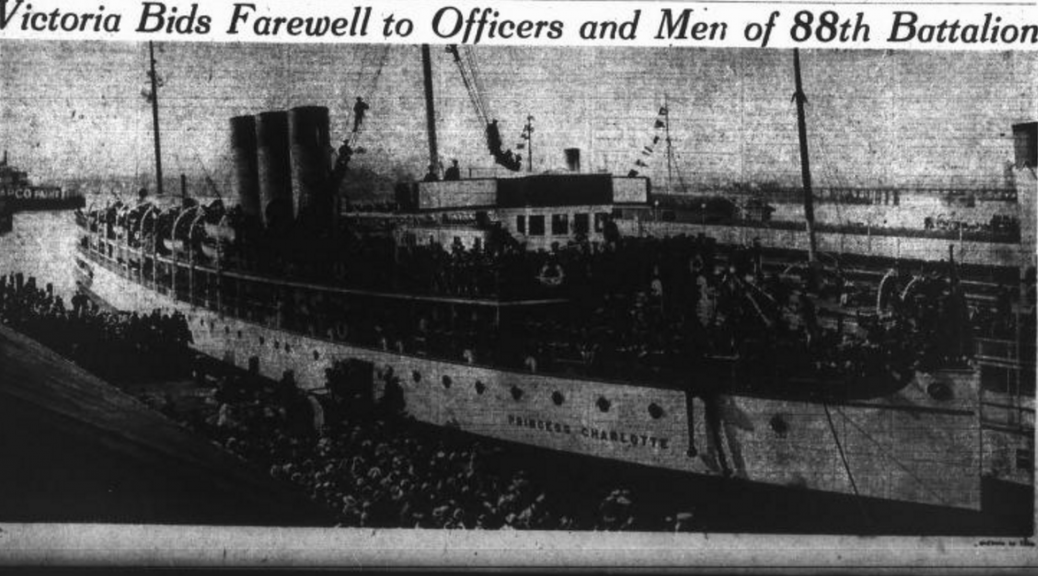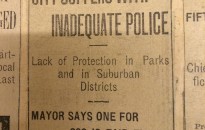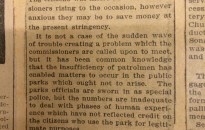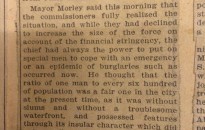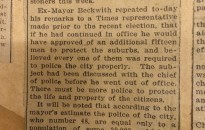Introduction
From 1914 to 1918, the Victoria Police Department said farewell to 17 officers who enlisted for military service.
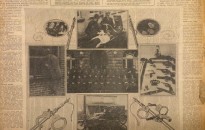

Two did not return and four were injured. Most of the officers, served initially in the 16th Canadian Expeditionary Force Battalion as it drew many recruits from the Victoria-based 50th (Gordon Highlanders) Regiment now known as the Canadian Scottish Regiment (Princess Mary’s). A few of the 17 served in the active militia as part of the 50th Regiment, but for others they had limited experience. Charles Taylor was the only one who originally enlisted in a British regiment: the Royal Irish Rifles.
Based on the fact the Victoria Police Department had 53 officers to administer to a population of 35,000 in 1924, having 17 men serve overseas throughout the Great War is a tremendous loss in manpower. The domestic implications are discussed in “Keeping the Peace at Home.”
It is possible the police officers saw the military as a natural extension of their duties to protect the City of Victoria or wanted a sense of adventure. There is no doubt the Victoria Police Department supported the war effort overseas both great and small alike. Arthur Christopher Sutton would rise through the ranks from private to lieutenant-colonel during the Great War and the Siberian Expedition. Others would assist in logistics from issuing pay slips, such as John Clarence Scott, tending the wounded like J.G. Rogers, or helping to manage soldiers in England as John George Forster did. This section is dedicated to those who were wounded or killed in the Great War and examines their service.
Notes on the Table
Below is a list of those who served in the Great War that includes their rank, unit, and name.
It should be noted the Canadian Expeditionary Force numbered their battalions, and therefore there is no real logical order to determine their origin.
Letters beside the rank denote decorations or awards. For instance, “D.S.M.” for A.C. Sutton means he received the Distinguished Service Order while F. Hatcher’s “M.M” means “Military Medal.” All those who survived were awarded the Victory Medal and British War Medal.
| Name | Rank | Battalion |
| Lic. Insp. F. Hatcher | Battalion Sergeant. Major F., M.M. |
3rd Canadian Divisional Ammunition Column |
| J.C. Scott* | Sergeant | 16th Battalion |
| C. Taylor* | Major |
Royal Irish Rifles (British Regiment) |
| Det. S. Sicilano^ | Private | 11 Canadian Mounted Rifles (now the British Columbia Dragoons) |
| Cons. A.H. Bishop | Sergeant | Royal Engineers |
| C.C Cremer. | Corporal | Military Foot Police. |
| Sgt. J. Florence. | Sergeant | 3rd Canadian Divisional Artillery Column |
| G.J. Forster^ | Corporal | 16th Battalion |
| R. Forster | Private | 16th Battalion |
| J. Ireland | Private | 88th Battalion |
| F. Jones | Private | Forestry Battalion |
| G. Ritch. | Farrier | 2nd Canadian Divisional Artillery Column |
| J.H. Rogers | SGT | Canadian Army Medical Corps |
| A.C. Sutton^ | Major/Lieutenant-Colonel, D.S.M. | 16th Battalion |
| W. Shawyer^ | Lieutenant | 16th Battalion |
| A.C. Simmons | Sergeant | 143 Battalion (B.C. “Bantams”) |
| G.B. Thompson | Sergeant | 102 Battalion |
| * Killed in Action ^ Wounded in Action |
||
Courtesy of the Victoria Police Department Archives.
